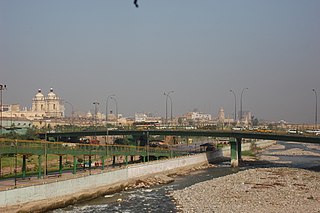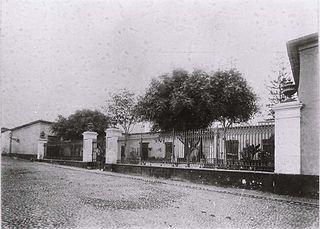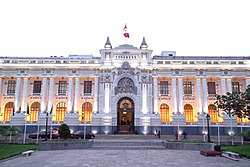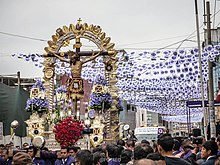
The Walls of Lima were a fortification consisting mainly of walls and bastions whose purpose was to defend the city of Lima from exterior attacks. It was built between 1684 and 1687, during the Viceroy Melchor de Navarra y Rocafull 's government.

Lima is a district of Lima Province in Peru. Lima district is the oldest in Lima Province and as such, vestiges of the city's colonial era remain today in the historic centre of Lima, which was declared a UNESCO World Heritage Site in 1988 and contains the foundational area known as Cercado de Lima.

Rímac, known until the 19th century as the neighbourhood of San Lázaro, is a district in the Lima Province, Peru. It lies directly to the north of downtown Lima, to which it is connected by six bridges over the Rímac River. The district also borders the Independencia, San Martín de Porres, and San Juan de Lurigancho districts. Vestiges of Lima's colonial heyday remain today in an area of the Rímac district known as the Historic centre of Lima, which was declared a UNESCO World Heritage Site in 1988. Downtown Rímac District has, like its southern counterpart, its eastern and western sides divided by Jirón Trujillo, which connects to Lima District's Jirón de la Unión through the Puente de Piedra, the oldest bridge in the whole city. Rímac's East side features the Plaza de Acho, the most famous bullfighting arena in South America and one of the most well known in the world.

The Historic Centre of Lima is the historic city centre of the city of Lima, the capital of Peru. Located in the city's districts of Lima and Rímac, both in the Rímac Valley, it consists of two areas: the first is the Monumental Zone established by the Peruvian government in 1972, and the second one—contained within the first one—is the World Heritage Site established by UNESCO in 1988, whose buildings are marked with the organisation's black-and-white shield.
The Historic Centre of Trujillo is the main urban area and the most important center of development and unfolding in the Peruvian city of Trujillo located in La Libertad Region. The whole process of its original urban fabric is in elliptical shape surrounded by España Avenue that was built in the wake of the Wall of Trujillo. It houses the seat of city government and other important entities in the locality. In the center of this historic urban area is the Plaza de Armas of Trujillo that was the scene of the Spanish founded of the city in 1534 and the proclamation of the independence of Trujillo on December 29, 1820.

The Quinta de Presa is a French-style country mansion built in the 18th century during the government of the then viceroy of Peru, Manuel de Amat y Junyent. It comprises a constructed area of 15,159 square metres (163,170 sq ft). It is located in the jirón Chira of the Rímac district, Lima, Peru.

Italy Square, formerly known as Saint Anne's Square, is a public square in the Barrios Altos neighbourhood of Lima, Peru. It was the second square built by the Spanish during the colonial era and later served as one of the four squares where the independence of Peru was declared in the city.
Jirón Amazonas is a major street in the Damero de Pizarro, located in the historic centre of Lima, Peru. The street starts at its intersection with the Jirón Lampa and continues until it reaches Sebastián Lorente Avenue.

Jirón Áncash is a major street in the Damero de Pizarro, located in the historic centre of Lima, Peru. The street starts at its intersection with the Jirón de la Unión at the Puente de Piedra, and continues until it reaches the Óvalo de la Paz.

Jirón Junín is a major street in the Damero de Pizarro, located in the historic centre of Lima, Peru. The street starts at its intersection with the Jirón de la Unión and continues for 19 blocks until it reaches Nicolás Ayllón Avenue.

Jirón Trujillo is an important street in Rímac District, part of the historic centre of Lima, Peru. The street starts at the Puente de Piedra, where it is continued on the other side of the Rímac River by the Jirón de la Unión, and continues until it reaches the Alameda de los Bobos. It therefore joins the so-called monumental zones of both Rímac and Lima districts.

The Church and Convent of the Good Death, also known as the Church of Saint Camillus, after the order's founder, is a Catholic church and convent in the colonial area of the neighbourhood of Barrios Altos in Lima, Peru. The current temple was built at the end of the 19th century and is dedicated to Our Lady of the Good Death. It is located at the crossroads of the Áncash and Paruro streets, and is diagonal to the Trinitarian Church of Lima.

The Church and Convent of Our Lady of Peñafrancia, better known as St. Clare's Monastery, is a Catholic church, convent and monastery belonging to the Capuchin Poor Clares located in the neighbourhood of Barrios Altos, part of the historic centre of Lima, Peru.

Balta Bridge, also known as the Iron Bridge is an iron bridge, the first of its kind in the city of Lima, that crosses the Rímac river, connecting the Jirón Amazonas to the south and the Avenida 9 de Octubre to the north.

Jirón Agustín Gamarra is one of the main streets of the district of La Victoria, also forming part of the neighbourhood of Barrios Altos, itself part of the historic centre of Lima, Peru. Over forty blocks long, it is best known for the Gamarra Commercial Emporium, which houses fashion stores and textile manufacturing workshops.

Jirón Puno is a major street in the Damero de Pizarro, located in the historic centre of Lima, Peru. It starts in the Jirón de la Unión and continues until it reaches Jirón Lorenzo de Vidaurre in Barrios Altos. It is continued by Jirón Moquegua to the west.

Ricardo Palma Bridge is a reinforced concrete beam bridge that crosses the Rímac river, connecting Abancay Avenue with Jirón Hualgayoc and thus connecting the districts of Lima and Rímac, both part of the historic centre of Lima, the capital city of Peru. It is named after the Peruvian author, scholar, librarian and politician Ricardo Palma.

The Hospital Civil de la Misericordia, also known as the Hospicio de Insanos or Manicomio del Cercado, was a mental institution that operated in the former Quinta Cortés of the neighbourhood of Barrios Altos, in Lima, Peru, between the years 1859 and 1918. A Civil Guard training school was inaugurated on the former hospital's premises after its closure, which is currently used by the National Police of Peru.

The Church of Our Lady of the Forsaken and of Saint Joseph, known commonly as the Church of the Forsaken, is a Catholic church located between Venezuela Avenue and the Jirón Recuay of the main square of Breña, in Lima, Peru.

The Church of Saint Anne is a Catholic church that forms part of the historic centre of Lima, Peru. It is located in Barrios Altos, next to Italy Square, and is one of two main candidates for the location of Rímac, the Indian oracle that gave the local river—and thus the city—its name. For this reason, the site receives the name of Huaca de Santa Ana.
























